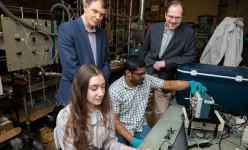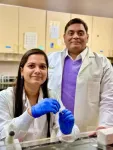(Press-News.org) A research team from New Jersey Institute of Technology is uncovering mysteries surrounding fluids in nanoporous materials, and has been recently awarded a grant from the National Science Foundation (NSF) to support this research.
The research is focused on the elasticity, or compressibility, of fluids in these nanopores. Understanding the elastic properties of fluids has significant implications across multiple disciplines. Engineering applications, geological exploration, materials science and environmental studies stand to benefit from insights gained through this research.
While elasticity of fluids is well understood in bulk, in nanoporous materials at the microscopic level the fundamental properties of fluids are different, according to Gennady Gor, associate professor of chemical and materials engineering at NJIT and the principal investigator.
The primary objective of this research program is to develop a molecular theory capable of quantifying the effects of confinement on the elastic properties of fluids and utilize this theory to predict the transfer of energy — wave propagation — in fluid-saturated nanoporous materials.
Moreover, this research could affect the knowledge base of thermodynamic understanding and prediction. All thermodynamic properties have a relation to one another, including compressibility. This “equation of state” is a mathematical relationship that describes the state of a system in terms of its thermodynamic properties such as pressure, volume and temperature.
“Compressibility is one of the parameters which goes into the equation of state and if we see a deviation in compressibility, the whole equation of state should be changed,” said Gor. “The predicting of all thermodynamic properties should be revisited and this is extremely important for broader applications where thermodynamics of fluids and pores is considered.”
The research team will employ a combination of molecular-scale modeling and experimental techniques to investigate the effects of confinement on fluid elasticity. Molecular-scale modeling efforts will focus on studying hydrocarbons confined in pores of various sizes and surface properties, while experiments will be conducted using model materials such as porous glasses and porous carbon with well-defined pore sizes.
The experimental team works closely with the modeling team to test the validity and provide feedback for model evolution. In order to scale up molecular-scale models to simulate much larger systems over longer periods of time, certain simplifications and assumptions need to be made.
“So far, we are gratified to see that experimental measurements reproduce the predictions made by the model very well. However, figuratively speaking, we are still at the mouth of a cave and who knows what treasures are hidden inside," said Alexei Khalizov, co-principal investigator and associate professor of chemistry and environmental science at NJIT.
To test the models, researchers will fill a known fraction of the nanopores with fluid then probe the sample with an ultrasonic pulse. Their upgraded experimental setup allows for precision dosages of vapor from any fluid, previously they were only testing water, and fully automated experiments. According to Khalizov, the automation is a crucial element of the experiment because each point on the saturation curve sometimes may take an entire day; some samples have a high specific surface area and the diffusion in nanopores is slow.
The team’s lab will house vacuum-sealed, temperature-controlled chambers to ensure a consistent environment, which builds off of proof of concept developed by an NJIT alumnus, Jason Ogbebor, now pursuing a Ph.D. at MIT. Gor credits much of the origins of this project from the NJIT faculty seed grant and summer fellowship, which supported Jason’s research as an undergraduate. Ashoka Karunarathne, a postdoctoral research associate, joined the team and has been instrumental in expanding the project.
"Fluid elasticity is a crucial parameter that influences how fluids respond to changes in pressure, temperature, and other environmental factors," stated Gor. "Our findings will not only advance fundamental understanding but also have practical applications in diverse fields such as hydraulic systems design, natural resource exploration, energy-storage devices, new technologies at the water-energy nexus and chemical and biological separations."
The research builds upon earlier publications and will have implications for petroleum and water resource exploration, as well as greenhouse gas sequestration efforts. By studying the elastic properties of hydrocarbon fluids in nanopores, the research team aims to develop new theoretical models that will aid in these critical areas.
"We are excited about the potential of our research to contribute to advancements in fundamental science and practical applications. By unraveling the mysteries of fluid behavior in nanoporous media, we aim to pave the way for innovations that can address pressing challenges across multiple domains," said Gor.
The NSF grant will support this research project over the next three years, enabling the research team to make significant strides in understanding the complex interplay between fluid confinement and elasticity in nanoporous media.
END
NJIT research team discovering how fluids behave in nanopores with NSF grant
2024-03-28
ELSE PRESS RELEASES FROM THIS DATE:
New study shows association of historical housing discrimination and shortfalls in colon cancer treatment
2024-03-28
BIRMINGHAM, Ala. – A nationwide study of 196 cities shows that housing discrimination from 90 years ago still casts a historical shadow of inequities in colon cancer care today, S.M. Qasim Hussaini, M.D., of the University of Alabama at Birmingham and colleagues at the American Cancer Society and Johns Hopkins School of Public Health report in the journal JCO Oncology Practice.
In the 1930s, the federally sponsored Home Owners’ Loan Corporation, or HOLC, used racial composition to map out residential areas worthy of receiving mortgage loans and those areas to avoid. Neighborhoods ...
Social media use may help to empower plastic surgery patients
2024-03-28
Waltham — March 28, 2024 — For patients considering or undergoing plastic and reconstructive surgery (PRS) procedures, using social media to gather information and answer questions can enhance patient empowerment – potentially leading to increased autonomy and better decision-making, reports a study in the April issue of Plastic and Reconstructive Surgery®, the official medical journal of the American Society of Plastic Surgeons (ASPS). The journal is published in the Lippincott portfolio by Wolters Kluwer.
"Our study suggests that connecting to social media is associated with meaningful increases in empowerment for PRS patients, ...
Q&A: How to train AI when you don't have enough data
2024-03-28
Artificial intelligence excels at sorting through information and detecting patterns or trends. But these machine learning algorithms need to be trained with large amounts of data first.
As researchers explore potential applications for AI, they have found scenarios where AI could be really useful — such as analyzing X-ray image data to look for evidence of rare conditions or detecting a rare fish species caught on a commercial fishing boat — but there's not enough data to accurately train the algorithms.
Jenq-Neng Hwang, University of Washington professor of electrical and computer and engineering, specializes in these issues. ...
Wayne State University researchers uncover potential treatment targets for Zika virus-related eye abnormalities
2024-03-28
DETROIT - A groundbreaking study published in the journal iScience presents crucial insights into the ocular effects of Zika virus infection during pregnancy and offers promising avenues for therapeutic intervention.
Produced by a team of researchers in the Department of Ophthalmology, Visual and Anatomical Sciences at the Wayne State University School of Medicine, the paper, “Targeting ABCG1 and SREBP-2 mediated cholesterol homeostasis ameliorates Zika virus-induced ocular pathology,” provides compelling evidence of the ...
Discovering Van Gogh in the wild: scientists unveil a new gecko species
2024-03-28
You’ve probably seen nature depicted in art, but how often do you see an artwork hiding in nature?
When they saw the back of a lizard in the Southern Western Ghats, a group of scientists from the Thackeray Wildlife Foundation in India were reminded of Van Gogh’s The Starry Night. As soon as they figured out it was a new species, it was only apt to name it in honour of the famous painter.
“Cnemaspis vangoghi is named for Dutch painter Vincent Van Gogh (1853–1890) as the striking colouration of the new species is reminiscent of one of his most iconic paintings, The ...
Small birds spice up the already diverse diet of spotted hyenas in Namibia
2024-03-28
Hyenas are generalist predators (and scavengers) with a broad range of prey species. They are known for hunting (or scavenging) larger mammals such as antelopes and occasionally feed on smaller mammals and reptiles. Being flexible in the choice of prey is a strategy of generalists – and this even extends to small passerine birds, as scientists from the Leibniz Institute for Zoo and Wildlife Research (Leibniz-IZW) and the University of Ljubljana observed in Namibia: Spotted hyenas pursued red-billed queleas, picked them from the ground or the surface of a waterhole and swallowed them whole, at a success rate of approximately one bird every three minutes. These observations were described ...
Imaging detects transient “hypoxic pockets” in the mouse brain
2024-03-28
Using a bioluminescent oxygen indicator, Felix Beinlich and colleagues discovered a spontaneous, spatially defined occurrence of “hypoxic pockets” in the mouse brain. Their technique offers a way to learn more about brain oxygen tension (pO2), a measure of oxygen delivery and demand in brain tissue that changes dynamically but is not well understood. The findings could have implications for how rest and exercise affect pO2 in the human brain, including the role of these activities in conditions such as dementia, Beinlich et al. suggest. The researchers used a genetically encoded bioluminescent oxygen indicator called Green NanoLuc in mouse cortical astrocytes to ...
Dissolved organic matter could be used to track and improve the health of freshwaters
2024-03-28
The dissolved organic matter (DOM) from hundreds of plant and animal remains could be used to track and possibly restore the health of freshwater bodies, Andrew J. Tanentzap and Jérémy A. Fonvielle write in this Perspective. The broad range of compounds, or chemodiversity, of DOM has multiple effects in freshwaters, including providing nutrients to support food web productivity, reducing or enhancing contamination from pollutants, and influencing the metabolism of microorganisms important to the biogeochemical cycle. DOM may also reduce the heat that ...
Indoor air quality standards in public buildings would boost health and economy, say international experts
2024-03-28
There should be mandatory indoor air quality standards, say an international group of experts led by Professor Lidia Morawska.
Professor Morawska, Vice-Chancellor Fellow at the University of Surrey and Distinguished Professor at Queensland University of Technology, led the appeal to the World Health Organization to recognise the airborne transmission of the virus which causes COVID-19 early in the pandemic – and help minimise it.
Now, in a paper published by the prestigious journal Science, Professor Morawska's international team recommends setting standards for ventilation rate and three key indoor pollutants: carbon ...
Positive associations between premenstrual disorders and perinatal depression
2024-03-28
Women affected by premenstrual disorders have a higher risk of perinatal depression compared with those who do not, according to research published March 28th in the open access journal PLOS Medicine. The relationship works both ways: those with perinatal depression are also more likely to develop premenstrual disorders after pregnancy and childbirth. This study suggests that a common mechanism might contribute to the two conditions.
Menstruating women experience cyclical hormone fluctuations through puberty, menstrual cycle, pregnancy ...







